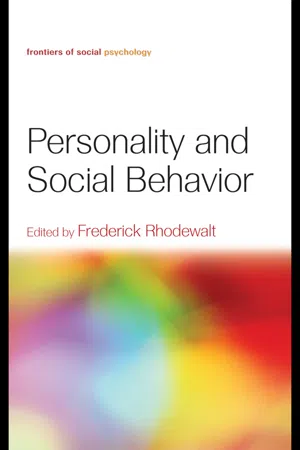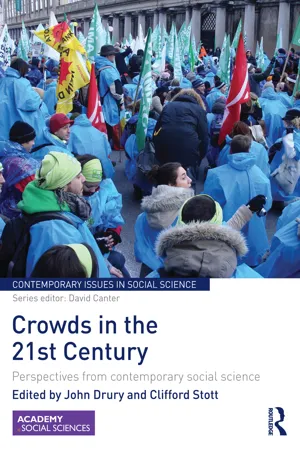Deindividuation
Deindividuation refers to the psychological phenomenon in which individuals lose their sense of self-awareness and personal responsibility when part of a group. This can lead to a decrease in inhibitions and an increase in impulsive or antisocial behavior. Factors such as anonymity, group size, and arousal can contribute to deindividuation.
4 Key excerpts on "Deindividuation"
- eBook - ePub
Experiments With People
Revelations From Social Psychology, 2nd Edition
- Kurt P. Frey, Aiden P. Gregg(Authors)
- 2017(Publication Date)
- Psychology Press(Publisher)
...Researchers have also found that when environmental cues make social responsibility salient, Deindividuation can lead to more altruistic behavior (Johnson & Downing, 1979; Spivey & Prentice-Dunn, 1990). For the most part, however, researchers have warned of the dark side of Deindividuation, claiming that it leads to unprincipled and harmful behaviors. But let’s back up. Uninhibited behavior in groups occurs for at least two general reasons. An anonymous group member might feel that he or she can get away with certain behaviors (by going undetected), or that he or she will not be held personally responsible for collective behaviors (diffusion of responsibility ; see Chapter 5). Either way, public self-awareness is reduced. The individual feels less conspicuous. He or she is less likely to be singled out, evaluated, criticized, or punished, and so is less concerned about approval, embarrassment, or retaliation by others. As in the fantasy of being invisible, behavior may be dramatically altered. Technically, however, getting away with bad behavior is not, in and of itself, Deindividuation. By definition, Deindividuation occurs when private self-awareness is reduced. The truly deindividuated person is alleged to pay scant attention to personal values and moral codes. He or she is claimed to be inordinately sensitive to cues in the immediate environment. Seeing others smash through storefront windows and escape with stereos and TVs during a looting spree, the deindividuated person is held to automatically join in, heedless of personal ethical qualms. The perpetrator is temporarily unaware of being an individual. Behavior is released from cognitive control as one becomes immersed in the pulsating crowd. In favor of this point of view is research that investigates what happens under opposite conditions—where people are made to focus on themselves, thereby increasing private self-awareness (Silvia & Duval, 2001)...
- eBook - ePub
You Can Beat Your Brain
How to Turn Your Enemies Into Friends, How to Make Better Decisions, and Other Ways to Be Less Dumb
- David McRaney(Author)
- 2013(Publication Date)
- Oneworld Publications(Publisher)
...They became aroused, lost their selves, and then went with the cues from their environment. Deindividuation is usually promoted in any organization where it is important to reduce inhibition and get you to do things you might not do alone. Soldiers and police don uniforms, warriors wear face paint, gangs have colors and dances and rituals. Businesses spend millions on team building in an effort to instill a deindividualized sense of worth. Celebrations by groups of football supporters have more potential to get out of hand than a party where no one feels absorbed by a group or protected by its norms. Deindividuation takes away your inhibitions, your sense of self, and your fear of accountability, but this isn’t necessarily a bad thing. The same force that influences otherwise rational people to loot and vandalize and invade Poland can also lead to prosocial behaviors. If you are surrounded by positive cues, Deindividuation could lead you to work harder in an exercise class, or pitch in at a homeless shelter, or help build a house. People who forget their sense of self and work together to save a life or search for a missing child show that Deindividuation is a neutral force of the human will. When Web communities such as 4chan or Reddit assemble into an anonymous collective to exact revenge, it often ends in actual justice. Once Deindividuation kicks in, the cues from the environment shape the resulting behavior. The norms of the mob, good or evil, replace the norms of everyday life. Robert D. Johnson and Leslie Downing showed in 1979 how manipulating environmental cues could change the behavior of deindividualized people. Their study was much like Zimbardo’s in that subjects were instructed to shock other people trying to learn a task. In their study, the people delivering the shocks wore either Ku Klux Klan robes or nurses’ uniforms. The subjects in the KKK costumes shocked more than control groups, and those in nurses’ uniforms shocked less...
- eBook - ePub
- Frederick Rhodewalt, Frederick Rhodewalt(Authors)
- 2012(Publication Date)
- Psychology Press(Publisher)
...7 Personality, Individuality, and Social Identity MICHAEL HOGG Claremont Graduate University The study of collective behavior has a long and illustrious history in social psychology. It was the study of collective behavior that very much defined the new discipline of social psychology at its inception in the late 19th and early 20th century, and collective phenomena such as crowds, riots, Deindividuation, and particularly group processes and intergroup relations have maintained a high profile ever since. However, at the same time social psychology has also focused on the self-contained individual person who processes and represents information, has feelings, engages in behavior, and interacts with individual others, an approach that often treats people as being fundamentally different from one another and having unique biographies and enduring personalities. Because these latter individual and interpersonal concerns appear more focused on what happens in the head of the individual, they have come to characterize social psychology and are often invoked as the basic unit of analysis and level of explanation to make sense of collective and group behaviors. As a result, there is an ongoing tension, and often a metatheoretical disagreement, between social psychologists who feel you can explain collective behavior in terms of individual personality and those who believe you cannot...
- eBook - ePub
Crowds in the 21st Century
Perspectives from contemporary social science
- John Drury, Clifford Stott, John Drury, Clifford Stott(Authors)
- 2015(Publication Date)
- Routledge(Publisher)
...According to this approach, individuals do not lose themselves in a crowd, but shift their self-categorisation from the individual (‘I’) to the group level (‘we’). Indeed, individuals who self-categorise as a group member (rather than as an individual) define and perceive themselves and their social world more in group (rather than individual) terms. As a consequence, their behavior is guided more by the group’s norms (rather than one’s personal norms), and one acts to achieve the group’s goals (rather than individual goals). In this analysis, group behavior is as rational as individual behavior, but the particular self-underlying and motivating behavior is different (Postmes & Spears, 1998; Reicher, 2001; Spears, 2010). With this recognition of the rationality of the group, it becomes possible to understand the crowd as a specific case of a psychological group in which in-group members are also physically co-present. Violence in crowds is therefore just one potential outcome of the collective action that individuals in crowds undertake, but solidarity and prosocial behavior are at least as likely (e.g. Drury et al., 2009). Based on these insights into the crowd, theory and research has moved in different ways. For instance, the Elaborated Social Identity Model (ESIM) of Drury, Stott, Reicher, and colleagues analyses the intergroup dynamics that govern crowd behavior (e.g. Drury & Reicher, 2009; Stott et al., 2001). These depend on, for example, the group norms that develop over time as a function of how a crowd and the police (or more generally the out-group) respond to each other. Rather than focusing on such intergroup dynamics, however, we focus on the intra-group process of whether individuals in a crowd can use the physical co-presence of in-group members as a psychological cue to in-group support. However, even when focusing on intra-group processes, important aspects of the inter-group situation remain important...



